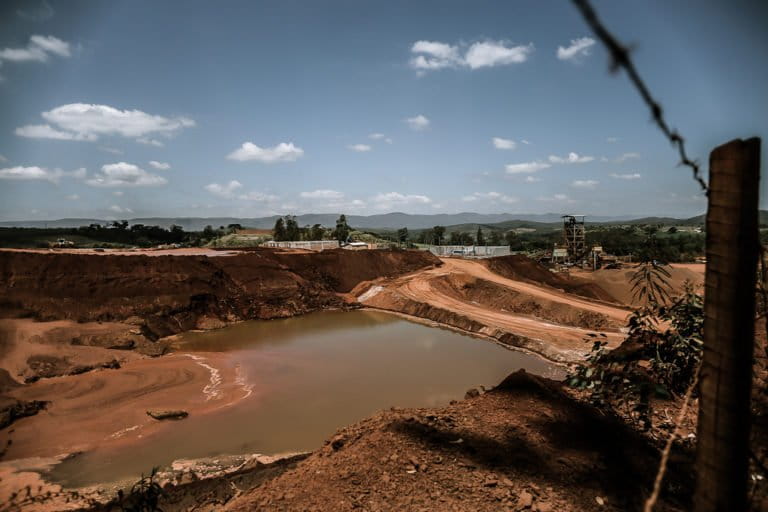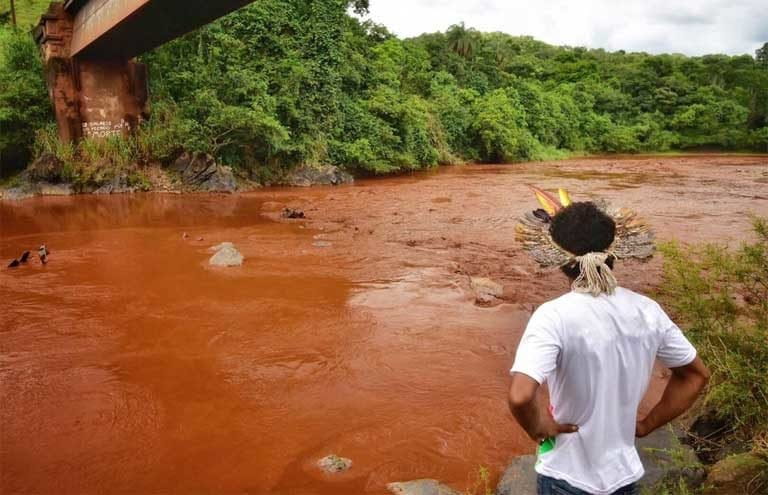- In 2019, the collapse of an iron-ore tailings dam in Brumadinho, southeastern Brazil, killed 272 people, flattened entire villages, and caused widespread environmental damage.
- Since then, engineers have tried to understand the mechanics of how a dam that hadn’t been in use in three years, and of which there are tens of thousands around the world, could have failed so suddenly and catastrophically.
- A newly published study by researchers at the Swiss institute ETH Zurich proposes a model for the mechanism that caused the collapse and the main causes behind the delayed failure.
- They posit that this model could be useful to help facilitate future risk assessment for other decommissioned tailings dams.
In January 2019, a dam holding back mining sludge at the Córrego do Feijão iron ore mine in Brumadinho, southeastern Brazil, collapsed. Around 10 million cubic meters (2.6 billion gallons) of the liquefied waste, or tailings, burst out of the dam, flattening nearby settlements, destroying a railway bridge, sending a surge of toxic mud into the Paraopeba River. In all, the disaster killed 272 people. The company behind the dam, Vale S.A., Brazil’s biggest miner, was ordered to pay $7 billion in damages to the affected communities.
The collapse caught many by surprise; it occurred without any warning, and three years after the mine had stopped dumping its tailings there. The dam had passed safety inspections, and had been equipped with state-of-the-art monitoring equipment. An investigative committee set up to understand what caused the breach concluded that the accident was likely due to imperceptible deformations of the sediment making up the dam, a phenomenon known in industry parlance as “creep.” But they were unable to describe the exact physical mechanism behind the idea.

Now, five years after the collapse, geotechnical engineering researchers at ETH Zurich, the Swiss federal institute of technology, have depicted the exact physical mechanisms that caused the catastrophic collapse. Their findings, published in the journal Communications of Earth & Environment, detail a new model for risk analysis that could make both active and closed dams safer.
“A dam is a live organism,” study co-author Alexander Puzrin, a professor of geomechanics and geosystems engineering at ETH Zurich, told Mongabay. Puzrin, who has studied natural and manmade geohazards for over three decades, said that as tailings settle, they are constantly changing. And even after the end of tailings being deposited, this activity continues as the settling sediment degrades and pressure shifts.
The researchers used the evidence gathered through the initial investigation and precise computer modeling to simulate the mechanics leading to the dam’s delayed failure. They found that after its closure, continuous shifting of the tailings material enlarged several existing “slip surfaces” within the dam. These are planes within the dam material and the tailings sediment that sit between the moving part of a mass and the solid part; they’re also the weakest point at which a landslide or collapse can occur. Over time, these slip surfaces reached a critical length, at which they spread out rapidly, causing the collapse of the entire dam.

The paper adds to the original expert report in an interesting way, dam engineer Mike Cambridge told Mongabay in an email. U.K.-based Cambridge, who was not involved in the study, has more than 50 years of experience planning, designing, constructing and operating mining projects around the world. He said that while the methods the ETH Zurich researchers used aren’t new, the framing around a single dam event is unusual. However, he said the adoption of this methodology may have limited relevance to other mining waste facilities.
Slow shifts inside the dam
Tailings are the materials left over once the economically valuable minerals have been extracted from mining ore, and they’re often discarded as slurry in what’s known as a tailings pond. One of the most common types of dam constructions to contain these ponds is an upstream dam, where berms are built on top of previously deposited slurry from which the water has drained or evaporated. Upstream dams are cheaper to build than other methods, but they’re more unstable because they’re built on top of mining waste rather than over solid ground. Several countries have now banned the construction of such tailings dams, including Brazil, where the ban came into force after the Brumadinho collapse.
External factors such as earthquakes or heavy rainfall or new deposits can cause slip surfaces to grow within these dams, leading to their collapse. Puzrin’s study shows that some initial slip surfaces had already appeared in the dammed tailings during the construction of the dam, but remained too small to cause a collapse. Over time, however, tiny, slowly accumulating displacements of materials, made worse by the brittle nature of the tailings and the way they’d been deposited, were enough to allow the slip surfaces to reach a critical mass, causing the catastrophic collapse of the dam.
In the specific case of the Córrego do Feijão dam, the tailings had high iron content. Initially, the iron particles stuck together like cement, but they also were very brittle, Puzrin said. “You load and load and load and suddenly it collapses. This is because of this very fast growth of cracks in the material, it’s a very brittle material,” he said. This rapid breakdown of the iron-heavy sediment didn’t allow enough time for the excess pressure to escape, which promoted the growth of slip surfaces.

A second important factor was creep, where the material inside the dam slowly deformed over time under constant stress. “When you load material it deforms. Some materials continue deforming under the constant load,” Puzrin said. The presence of fine particles within this material increased the rate of this deformation. The tiny shifts combined with the brittle nature of the tailings meant that slip surfaces were able to grow even without added pressure from new tailings, resulting in the delayed failure.
Finally, the study shows that the layering of tailings while the dam was still in operation also contributed to its failure. The slurry was layered in such a way that coarser sediment was placed at the bottom and finer sediment at the top. This created alternating layers of fine and coarse sediment, making the dam and everything it held back more unstable. The slip surfaces started in these fine layers, and the layered structure allowed the failure to spread horizontally. “Once the slip surfaces reached a critical length, it went very fast,” Puzrin said.
Lessons for the industry
The relevance of this study goes beyond just finding an explanation for the mechanics of the Córrego do Feijão dam’s collapse. “Studying this case is not just a curiosity but also might have an impact on how we treat future dams,” Puzrin said.
Part of the study involved creating quantifiable models that could be extrapolated to other dams. There are tens of thousands of tailings dams all over the world; China alone has 8,000, while Vale still has 30 upstream dams in Brazil, of which 13 have been decommissioned. “We now know what to do and what to pay attention to,” Puzrin said. “Compared to the potential disaster, it’s not hard to check if the components are there that could also lead to a collapse.”

Whether mine managers will apply the lessons learned is another question, though. Dam construction information is proprietary, and the companies paying for them don’t always want to know about the risks, even if they can, Puzrin said. Other experts note that tailings failures often result, from pressure to prioritize production over safety.
Citation:
Zhu, F., Zhang, W. & Puzrin, A. M. (2024). The slip surface mechanism of delayed failure of the Brumadinho tailings dam in 2019. Communications Earth & Environment, 5(1). doi:10.1038/s43247-023-01086-9
Banner image: A torrent of mining waste killed nearly 300 people when a tailings dam at Vale’s mine in Brumadinho collapsed in 2019. Image courtesy of Alex Lanza/State Public Ministry of Minas Gerais (MPMG).
